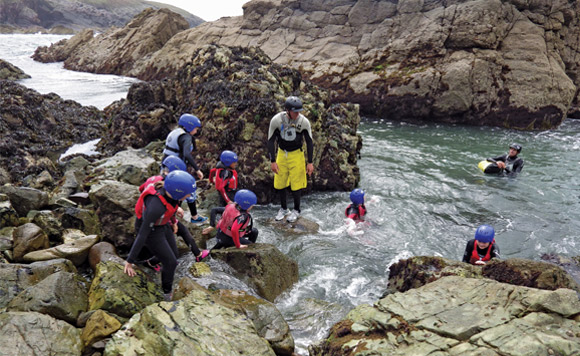– by Hans Tammemagi –
With eyeballs popping and muscles straining, I writhed and wriggled to get into a wet suit that seemed several sizes too small. I was in St. David’s in the southwestern corner of Wales, where the coastline is rugged, beautiful, and well suited for an obscure activity called coasteering, which involves swimming and clambering along a rocky coastline.
Coasteering was invented here, and I was about to immerse myself in it. Luckily, a dozen 10-year-old school children were in the group, easing my nervousness. Encased in our wet suits we walked clumsily through fields lined with hedges and old stone walls to the shoreline. Then, slowly and precariously I descended a vertigo-inspiring cliff. The schoolchildren scampered down like billy-goats.
We donned flotation jackets, helmets, and under the watchful eye of a guide, plunged into the foaming waves, the kids squealing and giggling. I followed quietly and apprehensively. I soon relaxed for it was perfectly safe, yet very exhilarating. We floated amongst rocks as the swell rose and fell in a soothing rhythm like the pulse of the earth. We cannon-balled into the foam and explored a sea cave. Occasionally, a cascade of water crashed over a nearby rock, soaking us. We frolicked for a long time.
Later – peeling off the wetsuit was unexpectedly easy – I learned that the activity of coasteering is growing fast and has spread through the UK and into France. Is Canada next, I wondered hopefully?
After lunch, I set off to explore the coastline, this time on the dry side, following the 1,400 kilometre-long Wales Coast Path that traces the entire coastline of the country. I headed north, clambering over frequent stiles, as waves crashed onto the rocks far below forming caves and stacks. Two hikers were silhouetted against the distant sky. There was a wonderful feeling of being part of a grander scheme.
A few hours later, I reached the village of Porthgain. The ruins of a castle, which once guarded a thriving port, rested on one side of the harbour. On the other side was my goal, the Sloop Pub. Soon I was inside, nursing a foaming pint of best bitter, reminiscing about the extraordinary coastline of bays, headlands, and estuaries sculpted into rugged cliffs that I had passed.
Next day, wanting to explore more, I sought out Laugharne, a pretty little village on the south coast of Wales. I strolled along Dylan Thomas Birthday Walk, which forms a small (two-mile) but fascinating part of the overall Coastal Path. The vast sweep of the Taf estuary with fishing boats bobbing in the distance dominated the view; the history- and blood-soaked Laugharne Castle loomed high above. Frequent signs described Thomas’ October Poem that he penned to describe this walk on his “thirtieth year to heaven.” I visited the Boathouse, now a museum and tea house, where Dylan once lived. Next door was a small boatshed with a grand view over the bay where Dylan wrote, a beer bottle and ashtray beside him. I hiked farther, passing herons fishing in the shallows and a quilt-work of green on the landward side.
Much later and pleasantly tired, I sipped an ale at Brown’s Hotel, Dylan’s local haunt, and planned my next steps along this glorious national treasure, the Wales Coast Path.




